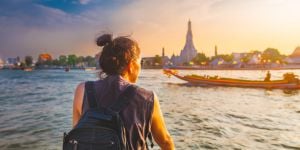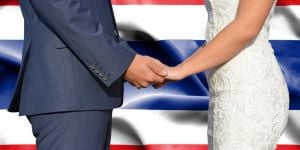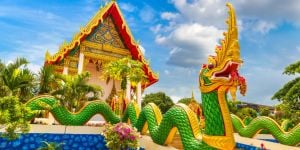Year for year, more visitors are coming to Thailand, in order to experience the legendary country of smile, its people and its beautiful nature. Most of these visitors come only to the seaside resorts as Pattaya, Phuket and Koh Samui. Some will also book a guided tour to other famous places as River Kwai or Chiang Mai. Only very few tourists however will visit the northeast of Thailand, the Isaan. That is the denomination for the northeastern part of Thailand. As here in history was the scene of the military conflicts between the Kings of Thailand and the Cambodian and Lao rulers, the possession of this area has changed some times between Thailand and the neighboring states. The ethnical presence of races from these countries can still be found today in Isaan, where the inhabitants are still speaking predominantly Lao or also the Cambodian language.
The Isaan covers about 1/3 of Thai national territory, and about 1/3 of the population of Thailand lives in this region. At first sight, the Isaan has not much in common with the regions of Thailand, into which the European tourists are generally interested. There are neither palm lined sea beaches, nor mountain chains covered with tropical rain forest. Depending upon the season, one sees only kilometer's of green rice fields or brown earth, baked to stone by month of a parching sun. This part of the country will thus hardly attract tourists, who want to enjoy themselves at the beaches. To anybody however, who is interested in the real picture of Thailand, outside of the large tourist centers, one can only recommend to make a visit to the Isaan, and to familiarize oneself withits people. The larger part of the population consists of ethnical Lao, who are of course Thai nationals, but speaking beside Thai also a Lao dialect, which has however many things in common with the Thai language. In Thailand are living nearly four times more peoples of Lao descent, then in the country of Laos itself.
The natives here have small figures and snub noses, which are fitting well to the lovely faces of the young girls. In the eastern part of the country, in the area around Buriram and Surin, areas formerly belonging to Cambodia and occupied by the kings of Siam during their conquest campaigns, the residents are ethnical Khmers. They have a figure more sturdy, straight noses and generally a somewhat darker skin than the Lao-Thais. The peoples here are speaking a Cambodian dialect, which differs completely both from the Thai language, as well as from the Lao language.
People living in Isaan do not only differ in their home language from the main part of the Thai population (being Thais, they speak naturally also all Thai language), but also in their traditions and customs. The people live mainly from farming, and as there falls substantially less rain than in the rest of Thailand, their revenues are accordingly much smaller. The Isaan is therefore often called the poorhouse of Thailand. It is for this reason that most of the girls earning their living and that of their families in the bars of Bangkok, Pattaya or Phuket, are originating from Isaan.
With the money made here, they can support their families at home, and help them to at least a modest standard of living. Although agriculture is nearly the only source of income in this country, the soil is relatively poor in minerals and therefore of low quality for agriculture. Because of the low water retention of the sandy soils, the cultivation of rice, requiring much water, is dependent on the irregular rainfalls, and is only possible in very small fields laying more deeply, which are surrounded by low earth banks, in order to retain for as long time as possible the water coming down in the rainy season. In contrast to the rice chamber of Thailand, the delta of the large rivers in central Thailand, where usually two rice harvests per year are possible, in Isaan only one rice harvest per year is obtainable.
The farmers are cultivating as well high-quality jasmine rice, which is generally produced for sale, and sticky rice, which is intended most for their own consumption. Hardly anybody in the villages will stay hungry, because enough rice is produced for everybody. But all other products, such as machines, spare parts, fuel and fertilizers have sharply increased in price in the last years, without that the prices for agricultural products would have risen. The farmers are therefore mostly indebted to financially strong landlords and banks. The land belongs only partially to the farmers, partially is it "king country" and the farmers have only the vested right to use it. Both, the property and the rights to use the land, can be sold or pawned however, and so the farmers must often back-lease their own fields from the banks, or creditors, and are therefore living at the edge of the subsistence level.
The whole rhythm of life of the rice farmers is determined by the seasons and the weather. If after the beginning of the rainy season the fields, stone-hard baked in the preceding months-long parching sun, are softened enough to be plowed, the farmers will run from early in the morning until late in the evening in the knee-deep water behind plow and harrow, preparing the small fields to sow the rice, which delivers some weeks later, if it has enough rain, the plants to be planted in rows in the fields. The planting of rice is very hard work, usually done by the women. They are walking bent over in a long row over the rice fields, covered with knee-deep water, and plugging the young rice-plants with 10 cm distance into the soil. As long as the rice planting is not finished, there is no Sunday or holiday for them.
Once the rice is planted, there remains for the farmers during some months nothing more to do, than to watch the rice growing. The men are sitting around all day long, drinking rice wine, talking, and waiting till the rice is ripened enough to be harvested. The women are occupied with weaving beautiful silken sarongs. Then with the arriving of the rice harvest, the hard work begins again. Since in Isaan the rice fields are somewhat small in size, and are enclosed by earth banks, in order to hold the precious rain water, no machines can be used. The rice must thus be cut by hand. Once the rice harvest finished, there is again rest for a few months, until the dry season is over, and the fields must once again be plowed.
Like the whole of Thailand, also the Isaan is strongly affected by the Buddhism, brought to Thailand in the 6.th century by Indian monks. The dominant religious customs existing before the arriving of Buddhism are however not exterminated in the memory of the people, but only overpainted by the teachings of Lord Buddha. The animism or the belief in ghosts is still deeply embedded in the life and the brains of the Isaan people. Especially the Buddhism of the people in the villages contains many animistic elements. There are naturally everywhere in the country people, especially the monks in the monasteries, studying seriously the teachings of Lord Buddha, and trying to live thereafter.
Everywhere in the Isaan one can find witnesses of an eventful past. Far more than in any other country inSoutheast Asia, one will meet the traces of old civilizations, as well ruins as splendidly restored temples.
In the proximity of the provincial capital of Khorat are situated the ruins of Prasat Phimai, the western strongpoint of the Khmer Kingdom. Another important temple ruin is Phanom Rung, near Prakonchai in the province ofBuriram. This Khmer temple compound was established on top of a 1000 meters high extinct volcanic cone, and is often called the Angkor Wat of Thailand. About 3 km east of Phanom Rung lays the temple of Prasat Muang Tam. This relatively small, however completely restored plant, is located in the midst of a very good maintained park, and gives a good impression of the monastery constructions at the time of the Khmer Kings. These are only some examples of the many objects of interest, the visitor can admire in Isaan.
This area was the center of a prehistorically civilization, which had its bloom time there in the bronze ages, 5.000 to 7,000 years ago. At excavations in the Udon Thani province, one finds skeletons and tools from this prehistorically time. Recently even 500,000 years old head fragments of a hominid were discovered, which lets assume, that beside Africa this area was one of the cradles of mankind. In the Isaan is also situated Thailand's oldest and largest national park, Khao Yai, mentioned in all travel guides. With over 2000 square kilometers, the large park covers parts of 4 provinces. One can still find here over 200 undomesticated elephants, and also tigers living in the rainforest. Beyond that, crowds of apes and about 180 different birds as well as approximately 50 different kinds of orchids.
The Isaan kitchen is much hotter than the Thai - kitchen, so that most Isaan dishes will drive tears into the eyes of the Farang. A typical Isaan dish is "Som Tam". This Isaan national dish is a vegetable mix, consisting of small chopped green Papayas, bulbs, tomatoes, lemon, pepper, salt and Chili. To improve the taste, a whole portion of rotten fish or crabs is added. It is above all the latter ingredient, which gives the whole mixture the typical smell, one can also say stench, which will generally prevent the Farang from the consumption of this delicacy. If a Farang however can be persuaded by his Isaan girl-friend, who could not live a day without Som Tam, to taste this hot dish, he should make sure before, to have a filled water bottle at hand, since otherwise after a few seconds flames will come out of his mouth..
Music in Isaan is quite different from the rest of Thailand. Some music serves as accompaniment for dances, some for are type of singing known as morlam, a traditional duet between a flirtatious male and a recalcitrant, ostensibly modest female, depending a great deal on the sauciness of its lyrics, and the improvised wit of the participants. One of the most distinctive instruments indigenous to Isaan is the Kharen, a bamboo wind instrument of vertical organ-like pipes which produces a unique sound. But in the hands of a virtuoso, the Khaen produces some of the most typical folk music heard in Southeast Asia.
The Farang may now think, that the life is in the Isaan is hard and primitive. But this is only true, if we judge it by our own standards. The people are poor, but by no means unfortunate or quarreling with their fate. Quite the contrary, they try to get as much Sanuk (fun) as possible from their for our terms toilsome life conditions. The peace from this leisurely life, and the harmony necessary for people living closely together under poor conditions, have unfortunately been lost by Farang, living in the hurry and stress of our western world.
Anyone who wants to get a good impression of the real Thailand should visit the Isaan. The Isaan people and their way of live are clearly difficult to understand and to accept for us Farang. We should however not see everything with our "Farang eyes", but must make an effort to put these blinders down. That is vividly to recommend to everybody, who wants to become acquainted with this country and with its people.
We do our best to provide accurate and up to date information. However, if you have noticed any inaccuracies in this article, please let us know in the comments section below.











